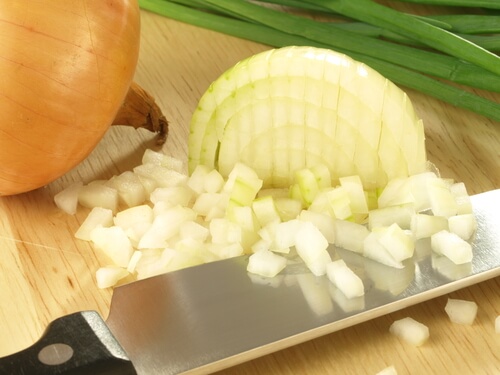Cutting Onions: 13 Ways to Stop Crying!

Many people know how uncomfortable it is to get that burning feeling in your eyes when you’re cutting onions. Most people end up looking like they’re crying!
Anyone who sees them like this they may think that the person is going through a bad time emotionally. This is a really annoying experience, and can make you feel pretty exasperated.
Why does cutting onions make us cry?
When you cut onions, they releases a substance called alliinase, which is what causes the emission of an irritating molecule called syn-propanethial-s-oxide or propanethial, which is the cause of the eye irritation and tears.
This molecule is a sulphurated essential oil, which catches easily in the nose and irritates the nasal mucus. When you breath in propanethial, its irritating action causes that annoying tearing and burning in the eyes. It’s so annoying that you sometimes have to leave the kitchen to recover.
Since most people tend to cry when they have to deal with onions, today we want to share with you the best tricks so that you can learn how to cut onions without tearing up. These tricks are based on avoiding or reducing the emission of the volatile substance, as well as minimizing its effects.
Read more: Onion Juice: How to Extract it and its Uses
The best tricks to stop the tears

- The first trick we recommend is to rub the cutting board with a piece of lemon before dicing the onion. Then you can cut it easily and it will help to prevent discomfort in your eyes. This trick can also help you prevent the strong smells of onion from penetrating into the board.
- If you are thinking about cutting an onion while you are cooking, try to put the knife in the freezer for 15 minutes before you cut. You should use it when it is pretty cold.
- Make sure you have a good knife to cut your onions. It should have a smooth and sharp blade.
- An excellent trick that often works is to cut the onion with your smoke extractor hood turned on.
- Another good option is to dice an onion in an area with good air flow. In this way, you’ll be able to disperse the acids that are released when you cut the onion. These are what cause you to cry.
- Another good option is to put the onion in the freezer for at least an hour before you cut it. The onion being cold will be very useful for preventing the annoying tears and burning.
- When cutting onions, put the knife in cold water or vinegar a few times. It is a very simple trick but it will only reduce tears by a little.
- Be sure to use a serrated knife. This will make more enzymes that cause burning and crying to be released and it’ll delay the crying.
Water and sunglasses
- Water can help get rid of the gas that the onion releases when you cut it, which is what causes burning and crying. It’s best to fill a container with water and put it close to where you are cutting the onions.
- Put boiling water where you are going to cut the onions so that the steam disperses the gases from the onion as you cut it.
- Although it may seem funny, you can use sunglasses or goggles while you cut onions. This trick will prevent the bothersome feeling of burning and crying and you’ll be able to cut your onions without any problem. In fact, there are glasses designed for cutting onions in stores and these cost around 20 dollars.
- Another trick that can work is to first cut the onion into big pieces and then let it soak in boiling water for a few minutes before cutting it into thin pieces.
- If none of these tricks work, you can consider substituting normal onions with green onions, although they won’t give your meals the same flavor.
All cited sources were thoroughly reviewed by our team to ensure their quality, reliability, currency, and validity. The bibliography of this article was considered reliable and of academic or scientific accuracy.
- Vågen, I. M., & Slimestad, R. (2014). Worth crying for: A search for mild and health-boosting onions for very long day conditions. In Acta Horticulturae. https://doi.org/10.17660/ActaHortic.2014.1040.46
-
Block, E. (2010). The Chemistry of Garlic and Onions. Scientific American. https://doi.org/10.1038/scientificamerican0385-114
This text is provided for informational purposes only and does not replace consultation with a professional. If in doubt, consult your specialist.








